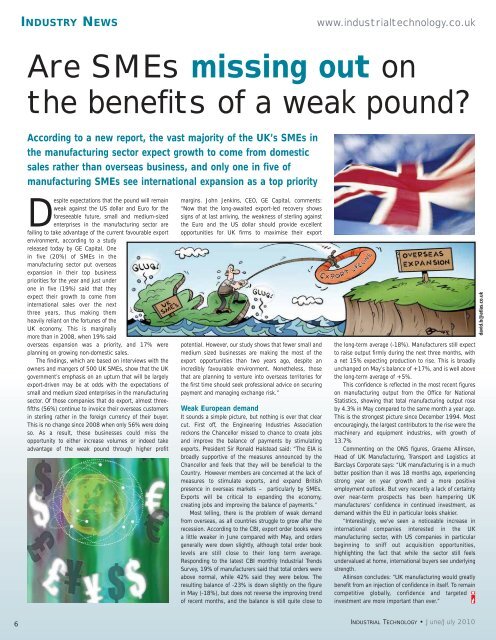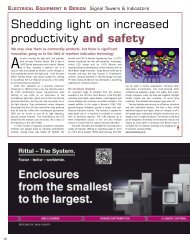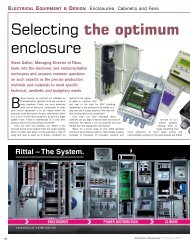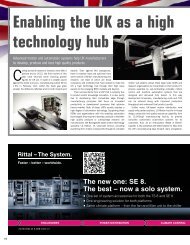drives, motors & controls - Industrial Technology Magazine
drives, motors & controls - Industrial Technology Magazine
drives, motors & controls - Industrial Technology Magazine
- No tags were found...
Create successful ePaper yourself
Turn your PDF publications into a flip-book with our unique Google optimized e-Paper software.
INDUSTRY NEWSwww.industrialtechnology.co.ukAre SMEs missing out onthe benefits of a weak pound?According to a new report, the vast majority of the UK’s SMEs inthe manufacturing sector expect growth to come from domesticsales rather than overseas business, and only one in five ofmanufacturing SMEs see international expansion as a top priorityDespite expectations that the pound will remainweak against the US dollar and Euro for theforeseeable future, small and medium-sizedenterprises in the manufacturing sector arefailing to take advantage of the current favourable exportenvironment, according to a studyreleased today by GE Capital. Onein five (20%) of SMEs in themanufacturing sector put overseasexpansion in their top businesspriorities for the year and just underone in five (19%) said that theyexpect their growth to come frominternational sales over the nextthree years, thus making themheavily reliant on the fortunes of theUK economy. This is marginallymore than in 2008, when 19% saidoverseas expansion was a priority, and 17% wereplanning on growing non-domestic sales.The findings, which are based on interviews with theowners and mangers of 500 UK SMEs, show that the UKgovernment’s emphasis on an upturn that will be largelyexport-driven may be at odds with the expectations ofsmall and medium sized enterprises in the manufacturingsector. Of those companies that do export, almost threefifths(56%) continue to invoice their overseas customersin sterling rather in the foreign currency of their buyer.This is no change since 2008 when only 56% were doingso. As a result, these businesses could miss theopportunity to either increase volumes or indeed takeadvantage of the weak pound through higher profitmargins. John Jenkins, CEO, GE Capital, comments:“Now that the long-awaited export-led recovery showssigns of at last arriving, the weakness of sterling againstthe Euro and the US dollar should provide excellentopportunities for UK firms to maximise their exportpotential. However, our study shows that fewer small andmedium sized businesses are making the most of theexport opportunities than two years ago, despite anincredibly favourable environment. Nonetheless, thosethat are planning to venture into overseas territories forthe first time should seek professional advice on securingpayment and managing exchange risk.”Weak European demandIt sounds a simple picture, but nothing is ever that clearcut. First off, the Engineering Industries Associationreckons the Chancellor missed to chance to create jobsand improve the balance of payments by stimulatingexports. President Sir Ronald Halstead said: “The EIA isbroadly supportive of the measures announced by theChancellor and feels that they will be beneficial to theCountry. However members are concerned at the lack ofmeasures to stimulate exports, and expand Britishpresence in overseas markets – particularly by SMEs.Exports will be critical to expanding the economy,creating jobs and improving the balance of payments.”Most telling, there is the problem of weak demandfrom overseas, as all countries struggle to grow after therecession. According to the CBI, export order books werea little weaker in June compared with May, and ordersgenerally were down slightly, although total order booklevels are still close to their long term average.Responding to the latest CBI monthly <strong>Industrial</strong> TrendsSurvey, 19% of manufacturers said that total orders wereabove normal, while 42% said they were below. Theresulting balance of -23% is down slightly on the figurein May (-18%), but does not reverse the improving trendof recent months, and the balance is still quite close tothe long-term average (-18%). Manufacturers still expectto raise output firmly during the next three months, witha net 15% expecting production to rise. This is broadlyunchanged on May’s balance of +17%, and is well abovethe long-term average of +5%.This confidence is reflected in the most recent figureson manufacturing output from the Office for NationalStatistics, showing that total manufacturing output roseby 4.3% in May compared to the same month a year ago.This is the strongest picture since December 1994. Mostencouragingly, the largest contributors to the rise were themachinery and equipment industries, with growth of13.7%Commenting on the ONS figures, Graeme Allinson,Head of UK Manufacturing, Transport and Logistics atBarclays Corporate says: “UK manufacturing is in a muchbetter position than it was 18 months ago, experiencingstrong year on year growth and a more positiveemployment outlook. But very recently a lack of certaintyover near-term prospects has been hampering UKmanufacturers’ confidence in continued investment, asdemand within the EU in particular looks shakier.“Interestingly, we’ve seen a noticeable increase ininternational companies interested in the UKmanufacturing sector, with US companies in particularbeginning to sniff out acquisition opportunities,highlighting the fact that while the sector still feelsundervalued at home, international buyers see underlyingstrength.Allinson concludes: “UK manufacturing would greatlybenefit from an injection of confidence in itself. To remaincompetitive globally, confidence and targetedinvestment are more important than ever.”david.b@atlas.co.uk6INDUSTRIAL TECHNOLOGY • June/July 2010
















